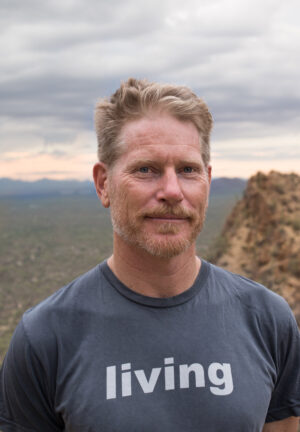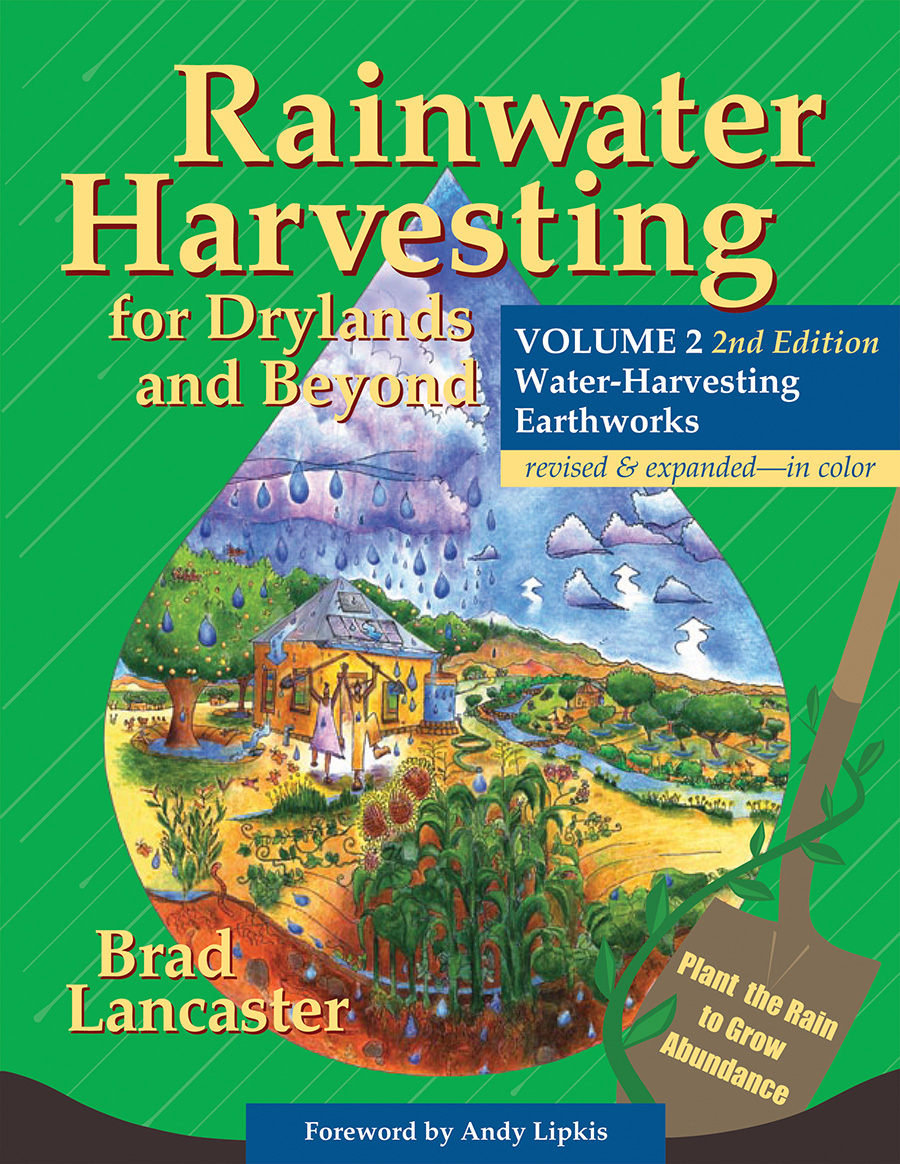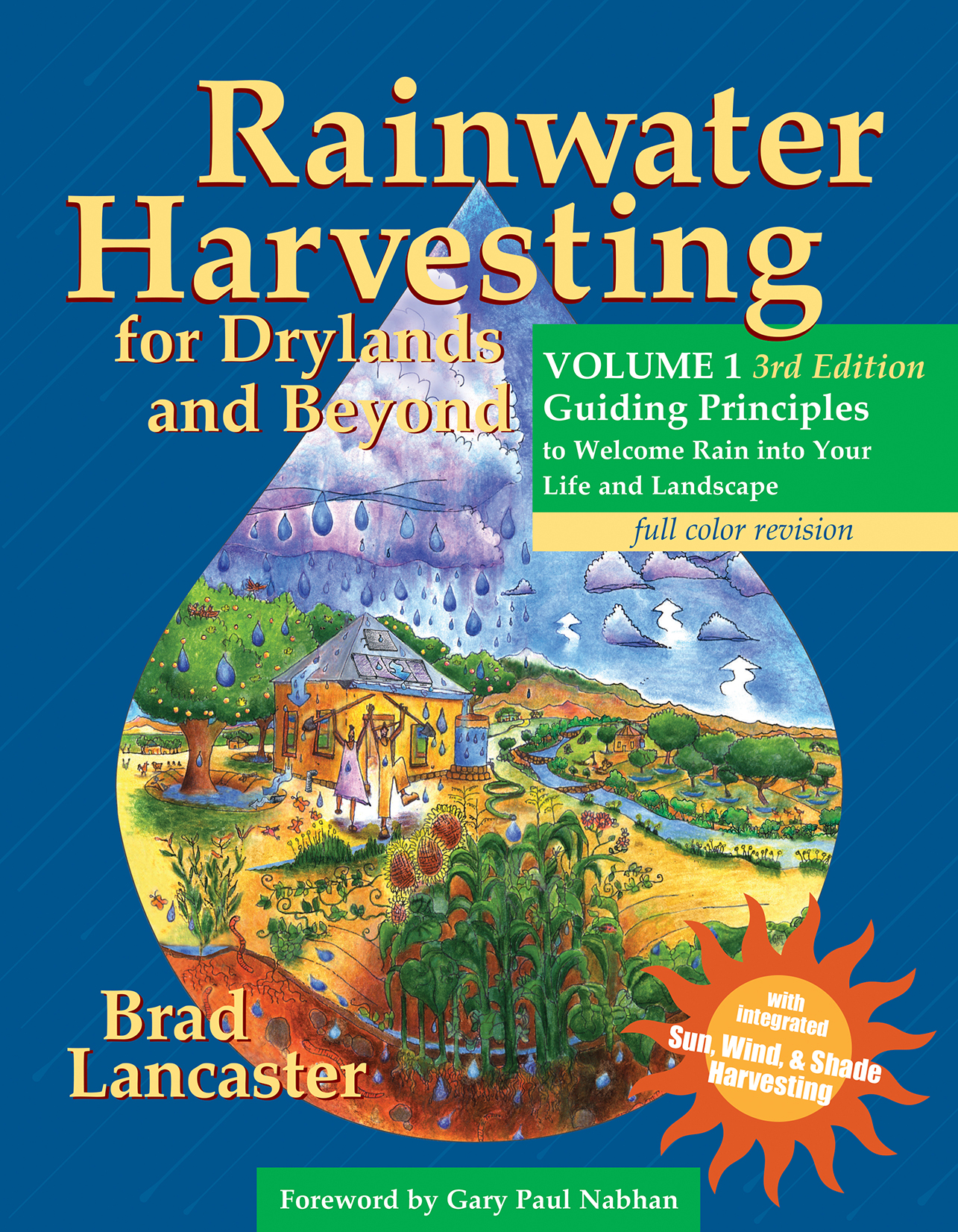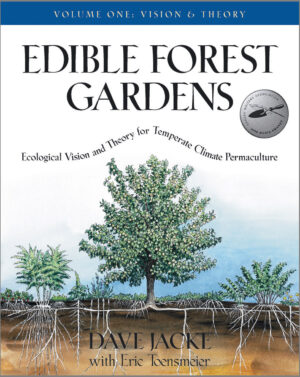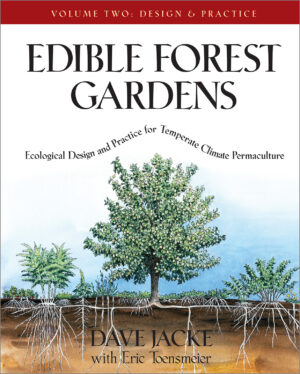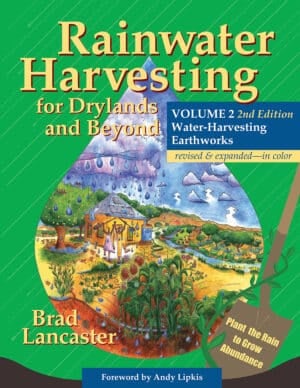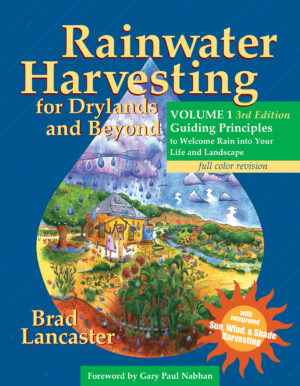Rainwater Harvesting for Drylands and Beyond, Volume 1, 3rd Edition
Guiding Principles to Welcome Rain into Your Life and Landscape
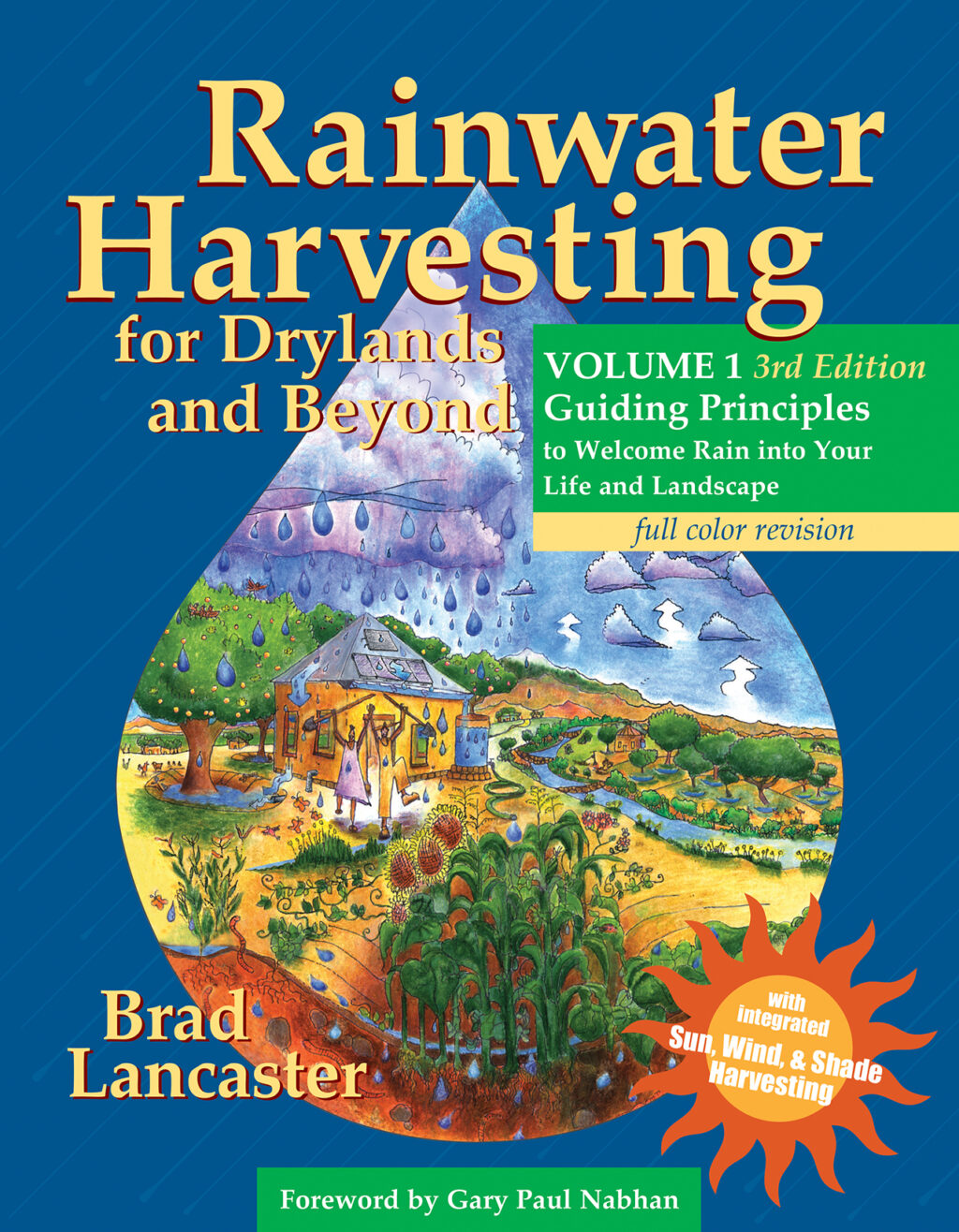
Rainwater Harvesting for Drylands and Beyond, Volume 1, 3rd Edition
Guiding Principles to Welcome Rain into Your Life and Landscape
2020 Independent Press Award Winner–Home & Garden Category
Turn water scarcity into water abundance! Rainwater Harvesting for Drylands and Beyond, Volume 1, 3rd Edition is the best-selling, award-winning guide on how to conceptualize, design, and implement life-enhancing water-, sun-, wind-, and shade-harvesting systems for your home, landscape, and community. This book enables you to assess your on-site resources, gives you a diverse array of strategies to maximize their potential, and empowers you with guiding principles to create an integrated, multi-functional plan specific to your site and needs.
Clearly written with more than 290 illustrations, this full-color edition helps bring your site to life, reduce your cost of living, endow yourself and your community with skills of self-reliance and cooperation, and create living air conditioners of vegetation growing beauty, food, and wildlife habitat. Stories of people who are successfully welcoming rain into their life and landscape will invite you to do the same.
Reviews and Praise
“Brad Lancaster has published a revised, third edition of his authoritative book Rainwater Harvesting for Drylands and Beyond: Volume 1, Guiding Principles to Welcome Rain into Your Life and Landscape. Lancaster has decades of experience in planting rain in Tucson, Arizona. He began to counter poor waterscape management after meeting water farmer Zephaniah Phiri Maseko. This man’s wisdom, and his practice of long and thoughtful observation of land to understand how rain flows through it and shapes it, is at the core of Lancaster’s rainwater harvesting practice. Tucson receives more water from falling rain than its consumers use. But destruction of the region’s forest, and development of impermeable urban zones has led to water scarcity, as Lancaster explains in this Ted talk. His book addresses this problem. It tweaks Maseko’s principles of water infiltration to fit the needs of his Tucson home. This involves creating mulch-filled depressions in his garden where rainwater infiltrates, and where household greywater can be diverted. It also involves applying these practices in the public arena; for instance, diverting rainwater from streets to irrigate crop-bearing trees on public land. Rainwater Harvesting’s five chapters walk the reader through principles of rainwater infiltration, using Lancaster’s own projects as case studies. The book’s appendices, which have been further developed in this new, colour edition, offer another incredibly valuable resource. They describe, for instance, patterns of water and sediment flow and how to best utilize them; traditional Southwestern rainwater harvesting techniques; a list of plants and their water requirements, and information on the water-energy-carbon nexus and how domestic rainwater harvesting saves energy and money, while reducing CO2 emissions. In short, any household or community committed to living sustainably by conserving and recycling water should read this book.”—International Rainwater Harvesting Alliance (IRHA)
More Reviews and Praise
“Brad Lancaster has done it again. In revising his excellent book, he has given us a window into the world through the lens of water. Water connects all things. And Brad shows us water as a practical way of considering context and connection. From a world of water as commodity, he takes us to a world of water as moving, enriching exchanges, the stuff of life. A native friend got a job with his local water company, and rather than an engineering job, he saw it as a sacred trust. This is the shift that Brad leads us carefully through. Water is wealth and health—let’s treat it that way, and dance our way from scarcity to abundance.—Joel Glanzberg, author of the The Permaculture Mind; tracker; and teacher / designer of regenerative living systems; PatternMind.org
“In a time of escalating resource scarcity and global conflict, this essential book helps us regain control of our water by showing us how to enhance our water and energy supply with simple, fun, and effective strategies at home and beyond.”—Maude Barlow, author of Blue Covenant; Senior Advisor on Water to the President of the United Nations General Assembly
“Brad Lancaster clearly defines the differences between the path to scarcity and the path to abundance, both revolving around the wise use of water while avoiding the consequences of careless use. Throughout the book, alternatives are plainly described with illustrations that get to the point. I have worked in the field with Brad. He is unabashedly committed to the parallel causes of water and energy conservation. He asks incisive questions, searches for answers, tests solutions, documents findings, and happily shares his conclusions with all who care to listen. Clearly Mr. Lancaster is an agent for change, a true innovator, providing simple but powerful solutions to difficult questions facing society in both urban and rural situations.”—Bill Zeedyk, Zeedyk Ecological Consulting, LLC; co-author of Let the Water Do the Work
“Lancaster’s book on rainwater harvesting is fantastic and an abundant guidebook for a more sane approach to our most precious resource. I highly recommend it.”—Jason F. McLennan, CEO, International Living Future Institute
“This book and the thinking behind it should be part of the basic education of civil engineers, architects, landscape architects, and planners everywhere. As a civil engineer working for a progressive municipal water utility in an arid climate, I can see if a majority of our citizens followed these practices, many of our current and future challenges would be alleviated. The positive side benefits in terms of erosion-control, creation of bird habitat, and natural cooling would be exceptional.”—Patricia Eisenberg, P.E., Past president, Arizona Society of Civil Engineers
“This wonderful book overflows with effective ways to beneficially cycle and enhance local water supplies, while maximizing power from the sun. It provides much-needed guidance and ideas on how to meet our resource needs, increase household and community potential, and protect the ecosystems upon which we all depend.”—Sandra Postel, founding director, Global Water Policy Project; Freshwater Fellow of the National Geographic Society; and author of Last Oasis
“In an age of enormous, industrial questions about resources, this book is an antidote. In these pages are solutions on a human scale, taking water not from massive reservoirs or river diversions but straight from the sky.”—Craig Childs, author of The Secret Knowledge of Water
“Though a bizarre irony, rainwater in the arid west is typically deflected away from water-starved land and shunted off to storm drains at great expense. Not so in Brad Lancaster’s universe. He welcomes rainwater into the landscape with creativity, intelligence, and humor, and puts it to use growing and enriching all kinds of resources, while reducing flooding and erosion, and enlivening the urban environment. In this new edition of Rainwater Harvesting for Drylands and Beyond, he welcomes us to join him in exercising the radical common sense of harvesting rainwater melded with the harvests of sun, wind, carbon, and more.”—Ann Audrey, Environmental Consultant, for integrating rainwater harvesting, habitat restoration, and edible trees
“This applies three times as much to the third edition: Buy this book now. If you live in a dry place, buy it. If you live somewhere subject to droughts (which is everywhere), buy it. The simple techniques (and the principles behind them) can help you save bundles of money, and make the landscape around you more productive and beautiful, with less work and upkeep than you can imagine. Lend it to your neighbors, and you’ll benefit as well. (Heck—buy them each a copy.) This how-to manual has enough stories, illustrations, and simple ideas to inspire even the most unhandy among us (such as myself). Buy it, try a couple of projects in your backyard, and in a few years be sure to send Brad and me a thank you note!”—Kevin Dahl, former Executive Director of Native Seeds/SEARCH and author of WildFoods of the Sonoran Desert and Native Harvest: Gardening with Authentic Southwestern Crops
Reviews and Praise
“Brad Lancaster has published a revised, third edition of his authoritative book Rainwater Harvesting for Drylands and Beyond: Volume 1, Guiding Principles to Welcome Rain into Your Life and Landscape. Lancaster has decades of experience in planting rain in Tucson, Arizona. He began to counter poor waterscape management after meeting water farmer Zephaniah Phiri Maseko. This man’s wisdom, and his practice of long and thoughtful observation of land to understand how rain flows through it and shapes it, is at the core of Lancaster’s rainwater harvesting practice. Tucson receives more water from falling rain than its consumers use. But destruction of the region’s forest, and development of impermeable urban zones has led to water scarcity, as Lancaster explains in this Ted talk. His book addresses this problem. It tweaks Maseko’s principles of water infiltration to fit the needs of his Tucson home. This involves creating mulch-filled depressions in his garden where rainwater infiltrates, and where household greywater can be diverted. It also involves applying these practices in the public arena; for instance, diverting rainwater from streets to irrigate crop-bearing trees on public land. Rainwater Harvesting’s five chapters walk the reader through principles of rainwater infiltration, using Lancaster’s own projects as case studies. The book’s appendices, which have been further developed in this new, colour edition, offer another incredibly valuable resource. They describe, for instance, patterns of water and sediment flow and how to best utilize them; traditional Southwestern rainwater harvesting techniques; a list of plants and their water requirements, and information on the water-energy-carbon nexus and how domestic rainwater harvesting saves energy and money, while reducing CO2 emissions. In short, any household or community committed to living sustainably by conserving and recycling water should read this book.”—International Rainwater Harvesting Alliance (IRHA)
“Brad Lancaster has done it again. In revising his excellent book, he has given us a window into the world through the lens of water. Water connects all things. And Brad shows us water as a practical way of considering context and connection. From a world of water as commodity, he takes us to a world of water as moving, enriching exchanges, the stuff of life. A native friend got a job with his local water company, and rather than an engineering job, he saw it as a sacred trust. This is the shift that Brad leads us carefully through. Water is wealth and health—let’s treat it that way, and dance our way from scarcity to abundance.—Joel Glanzberg, author of the The Permaculture Mind; tracker; and teacher / designer of regenerative living systems; PatternMind.org
“In a time of escalating resource scarcity and global conflict, this essential book helps us regain control of our water by showing us how to enhance our water and energy supply with simple, fun, and effective strategies at home and beyond.”—Maude Barlow, author of Blue Covenant; Senior Advisor on Water to the President of the United Nations General Assembly
“Brad Lancaster clearly defines the differences between the path to scarcity and the path to abundance, both revolving around the wise use of water while avoiding the consequences of careless use. Throughout the book, alternatives are plainly described with illustrations that get to the point. I have worked in the field with Brad. He is unabashedly committed to the parallel causes of water and energy conservation. He asks incisive questions, searches for answers, tests solutions, documents findings, and happily shares his conclusions with all who care to listen. Clearly Mr. Lancaster is an agent for change, a true innovator, providing simple but powerful solutions to difficult questions facing society in both urban and rural situations.”—Bill Zeedyk, Zeedyk Ecological Consulting, LLC; co-author of Let the Water Do the Work
“Lancaster’s book on rainwater harvesting is fantastic and an abundant guidebook for a more sane approach to our most precious resource. I highly recommend it.”—Jason F. McLennan, CEO, International Living Future Institute
“This book and the thinking behind it should be part of the basic education of civil engineers, architects, landscape architects, and planners everywhere. As a civil engineer working for a progressive municipal water utility in an arid climate, I can see if a majority of our citizens followed these practices, many of our current and future challenges would be alleviated. The positive side benefits in terms of erosion-control, creation of bird habitat, and natural cooling would be exceptional.”—Patricia Eisenberg, P.E., Past president, Arizona Society of Civil Engineers
“This wonderful book overflows with effective ways to beneficially cycle and enhance local water supplies, while maximizing power from the sun. It provides much-needed guidance and ideas on how to meet our resource needs, increase household and community potential, and protect the ecosystems upon which we all depend.”—Sandra Postel, founding director, Global Water Policy Project; Freshwater Fellow of the National Geographic Society; and author of Last Oasis
“In an age of enormous, industrial questions about resources, this book is an antidote. In these pages are solutions on a human scale, taking water not from massive reservoirs or river diversions but straight from the sky.”—Craig Childs, author of The Secret Knowledge of Water
“Though a bizarre irony, rainwater in the arid west is typically deflected away from water-starved land and shunted off to storm drains at great expense. Not so in Brad Lancaster’s universe. He welcomes rainwater into the landscape with creativity, intelligence, and humor, and puts it to use growing and enriching all kinds of resources, while reducing flooding and erosion, and enlivening the urban environment. In this new edition of Rainwater Harvesting for Drylands and Beyond, he welcomes us to join him in exercising the radical common sense of harvesting rainwater melded with the harvests of sun, wind, carbon, and more.”—Ann Audrey, Environmental Consultant, for integrating rainwater harvesting, habitat restoration, and edible trees
“This applies three times as much to the third edition: Buy this book now. If you live in a dry place, buy it. If you live somewhere subject to droughts (which is everywhere), buy it. The simple techniques (and the principles behind them) can help you save bundles of money, and make the landscape around you more productive and beautiful, with less work and upkeep than you can imagine. Lend it to your neighbors, and you’ll benefit as well. (Heck—buy them each a copy.) This how-to manual has enough stories, illustrations, and simple ideas to inspire even the most unhandy among us (such as myself). Buy it, try a couple of projects in your backyard, and in a few years be sure to send Brad and me a thank you note!”—Kevin Dahl, former Executive Director of Native Seeds/SEARCH and author of WildFoods of the Sonoran Desert and Native Harvest: Gardening with Authentic Southwestern Crops


